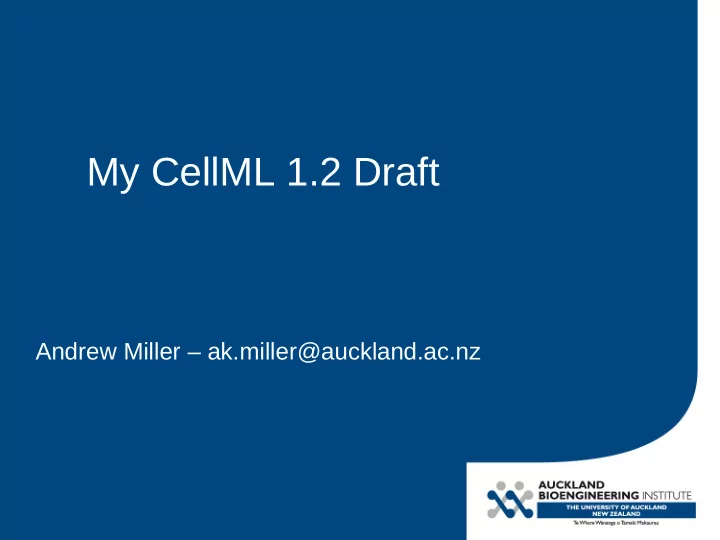

My CellML 1.2 Draft Andrew Miller – ak.miller@auckland.ac.nz
About the draft Git Repository (DocBook): http://repo.or.cz/w/cellml-draft-miller.git HTML Version: http://www.cellml.org/Members/miller/draft-normative-spec-andrews-preferred/toplevel.xhtml Proposes a number of changes over CellML 1.1. Form of specification is different, and more formal: 1. It is purely a specification, not a tutorial. Tutorials can be created separately. This cleanly separates normative material from non-normative. 2. It uses precise terminology, modelled after that used by the IETF define Internet protocols – the philosophy is that the specification should be precise, so implementing the specification carefully is enough to ensure interoperability. 2
Primary and secondary specs CellML 1.0 and CellML 1.1 are very general – they are just a container for math, and you can describe a diverse range of systems using that mathematics. This is good for extensibility – it means that I can create perfectly valid CellML 1.0 or 1.1 models that do far more than was contemplated when the specifications were drawn up. But... it is bad for interoperability – there is more than one way to represent the same thing (e.g. events), tools will often only support one form, and there is no specification. The 1.2 draft is again very broad. It is the primary specification, and it introduces the concept of a secondary specification. Secondary specifications are restrictive – models can say they comply with a secondary spec by only using things allowed by it – tools can say they can process every possible model compliant with it. Many changes will be possible with a new secondary spec, without changing the primary spec. 3
DAE / ODE / Scalar Reals Spec Git Repository (DocBook): https://github.com/A1kmm/cellml-dae-events-secondary HTML Version: http://www.cellml.org/Members/miller/draft-secondary-spec-dae-events/toplevel.xhtml To demonstrate the concept, I created a secondary specification (written against the 1.2 draft) for systems involving DAEs, ODEs, using a reasonable set of common mathematical operators, and defined only on real-valued scalars – this is still a work in progress. It will support intervention events using an infinitesimally delayed piecewise representation – a new operator is required to support delays, and this secondary specification will use that operator solely as the limit from above the current time to represent the value just before an event (that triggered the event). 4
Types The draft 1.2 specification proposes a type attribute, for data type information. type='real' is defined to mean real numbers. Everything other value is open for secondary specifications to define. Secondary specifications can then define things like vector and scalar. A further primary specification would be needed if we want to let users define their own types, as it would need new elements in the XML structure (secondary specifications only restrict interpretation, they can't add new elements). Only real valued variables need units.
Connections The draft simplifies connections. Directionality of connections is not mathematically meaningful information in a declarative model. x = f(y) in component C1, x = g(z) in component C2, if x is connected between C1 and C2, it just means C1.x and C2.x it is the same variable. Also, having a map_components element is unnecessary complexity – the draft makes component_1 and component_2 attributes of the connection.
Reactions CellML's niche is to represent mathematical models as mathematics, with all problem domain specific information (for example, information that is not part of the mathematical model, but provides chemical, biological, or physical context) being placed in the metadata. Reactions in CellML 1.0 and 1.1 are a deviation from this principle (and for this reason, most software doesn't implement them well anyway). The 1.2 draft removes them. People wanting reactions should either use SBML, which is designed to include this type of information, or encode models directly in mathematical form, and use metadata to describe the corresponding reactions.
Grouping and encapsulation Grouping serves two purposes in CellML 1.0 and 1.1. 1. It provides a general mechanism to provide information about the physical relationship of things (using the containment relationship and with user-defined extension groupings). These things do not affect the mathematical interpretation of the model or the validity at the CellML level. 2. It provides for encapsulation, which does affect whether a connection at the CellML level is valid or not. The first case is better served by metadata. The draft therefore simplifies grouping by: 1. removing the group and relationship_ref elements – things like containment should instead be defined using metadata. 2. adding an encapsulation element specifically for describing encapsulation.
Discussion Questions? Comments / Discussion? Suggestions? Criticism?
Recommend
More recommend